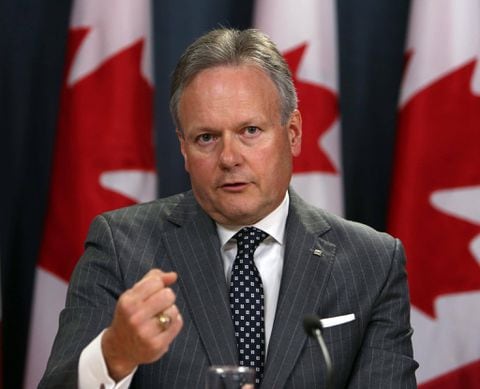Threat of NAFTA collapse, weak inflation put Bank of Canada on hold
Canada's central bank is hitting the pause button on hiking interest rates in the face of surprisingly weak inflation and the threat of NAFTA's demise.
The Bank of Canada kept its key overnight rate unchanged at 1 per cent Wednesday and appeared to push further down the road any future rate hikes.
The bank says that while the economy is now running close to capacity, inflation won't get back to its two per cent target until the second half of next year because of the recent strength of the Canadian dollar.
The Canadian dollar sank immediately after the announcement, touching its lowest level against its U.S. counterpart since July. By late morning, the loonie was trading at 78.22 cents (U.S.). It had been trading at 78.80 cents ahead of the rate decision.
"While less monetary stimulus will likely be required over time, [The Bank of Canada] will be cautious in making future adjustments to the policy rate," the bank said in a statement accompanying its rate decision.
The bank had previously suggested inflation would get back to 2 per cent in mid-2018.
The guarded tone of the statement suggests the Bank of Canada could delay its next move, which many economists had expected would come in December or January. The bank has already raised its key rate twice this year, from 0.5 per cent to 1 per cent.
"This reinforces our view that rates aren't likely to go any higher in the near term," economist David Madani of Capital Economics said in a research note.
The Bank of Montreal said it now expects the central bank's next rate increase to come in March, rather than January, and that it will hike just three times in 2018, instead of four.
"We now believe that the bank will pause for longer, given the greater uncertainty over NAFTA, as well as the recent steps taken by [regulators] to cool the housing market," BMO chief economist Douglas Porter said.
The bank pointed out that it will be closely watching several key pieces of incoming data, including wage growth and the response of consumers and businesses to recent rate hikes.
Meanwhile, the bank is ratcheting up its concern about the Trump effect on Canada's export-dependent economy. Rising protectionism in the U.S. is now "the greatest source of uncertainty" clouding Canada's economic outlook, the bank warns in its latest monetary policy report, also released Wednesday.
But the bank said it has chosen not to fully quantify the potential damage to Canada's economy and export prospects until it has more clarity about what will happen.
The bank cited both the uncertainty over NAFTA and "targeted discretionary" protectionist measures, such as the massive tariffs imposed recently on Bombardier Inc.'s new C Series commercial jets.
The NAFTA negotiations hit a major roadblock last week after the U.S. put tough demands on the table last week, including a minimum U.S. content threshold for manufactured goods, an end to the deal's dispute settlement regime and a phase out of Canada's protected dairy and poultry markets.
The bank said that while Canada's economy has been gaining strength this year, U.S. protectionism had cast a pall on the outlook.
"This outlook remains subject to substantial uncertainty about geopolitical developments and fiscal and trade policies, notably the renegotiation of the North American free trade agreement," the bank said.
Nonetheless, the Bank of Canada raised its forecast for growth this year to 3.1 per cent, or roughly in line with many private-sector forecasters. That's up from its July forecast of 2.8 per cent. Its GDP forecast for 2018 and 2019 remain largely unchanged, at 2.1 per cent (versus 2 per cent) and 1.5 per cent (versus 1.6 per cent) respectively.
The improvement in 2017 is largely due to a blistering first half, in which annual growth averaged 4 per cent.
The bank said it expects growth to "moderate to a more sustainable pace" in the second half – with annual GDP growth of 1.8 per cent in the third quarter and 2.5 per cent in the fourth quarter – due to weaker consumer spending and housing activity.
The bank blamed the pull-back on higher interest rates, tighter mortgage rules and measures in Ontario aimed at stemming the influx of foreign speculators in the housing market. Exports and business will continue to make a "solid contribution" to growth, the bank said.
The bank has also adjusted its main forecasting model because it now believes that record-high debt levels of Canadians have made "household spending more sensitive to interest rates than in the past."
Another growing concern for the central bank is the "unexplained softness" of Canadian inflation. The bank pointed out that while the unemployment rate has continued to fall, other labour market indicators are still lagging, including wage growth and average hours-worked, both of which remain below historical averages.
The bank released two research reports Wednesday, exploring the inflation puzzle, in Canada and globally.

